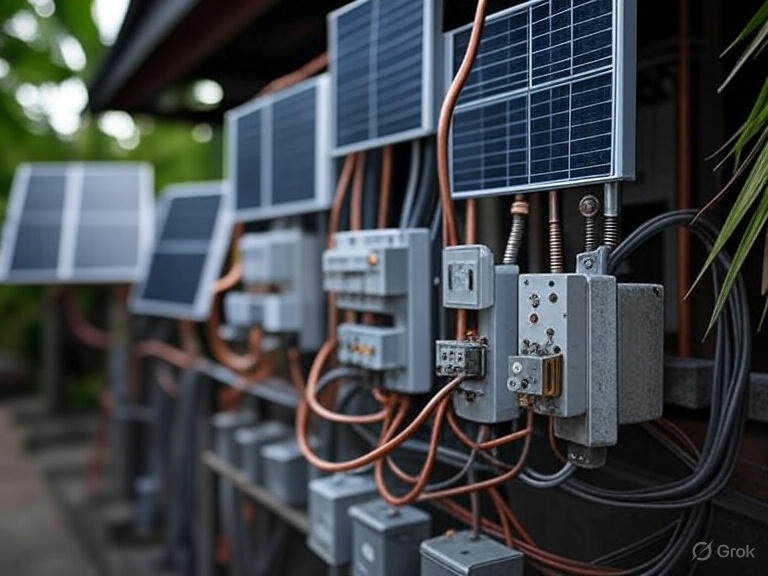
October 01, 2025 - Zed van der Vyver
Introduction to Electrical Systems in Thailand
Electrical systems are the lifeblood of any home or building in Thailand, powering lights, appliances, and modern conveniences in a country with a tropical climate and growing urban demand. They must handle humidity, heat, and occasional power surges. This blog will explain why electrical systems matter in Thailand, the different types for various needs, how they’re made, and what they might cost. No technical expertise required—just clear info to help you understand this vital infrastructure!
Why Electrical Systems Are Essential in Thailand
Electrical systems provide power for lighting, cooling, and devices, which are critical in Thailand’s hot climate—often exceeding 35°C in Bangkok or Chiang Mai. They enable fans and air conditioners to combat humidity, a constant challenge, and support rural areas with off-grid solutions during outages. Safety is key, as monsoon rains can damage wiring, and urban growth increases load demands. From a villa in Phuket to a rural home in Isaan, reliable electricity enhances comfort, productivity, and security.
Types of Electrical Systems for Different Scenarios in Thailand
Electrical systems vary by use and location, and the right type depends on your power needs and environment. Here’s a look at common types in Thailand and where they fit best:
Copper Wiring Systems
Use: Residential homes or offices.
Why: Durable and conductive, copper wires handle standard loads and resist corrosion in humid conditions.
Example Scenario: A house in Nonthaburi.
Aluminum Wiring Systems
Use: High-capacity or industrial builds.
Why: Lightweight and cost-effective for long runs, though less durable and requiring careful installation.
Example Scenario: A factory in Chonburi.
Solar Power Systems
Use: Off-grid or eco-friendly homes.
Why: Panels convert sunlight into electricity, ideal for rural areas or reducing costs in sunny Thailand.
Example Scenario: A farm in Chiang Rai.
Ground Fault Circuit Interrupter (GFCI) Systems
Use: Wet areas or safety-focused builds.
Why: These outlets cut power during faults, protecting against shocks in bathrooms or kitchens.
Example Scenario: A condo in Phuket.
Your choice depends on power demand, safety needs, and location. Thai brands like Schneider Electric or local suppliers offer region-specific solutions.
How Electrical Systems Are Made in Thailand
Electrical components in Thailand are manufactured to withstand heat and humidity while meeting safety standards. Here’s a general overview of the process:
- Material Selection: Copper and aluminum are sourced, often recycled locally. Solar panels use silicon cells, imported or assembled in Thailand.
- Wire Drawing: Copper or aluminum is drawn into thin wires, coated with insulation (e.g., PVC) to resist moisture.
- Assembly: Wires are bundled into cables, fitted with connectors, and paired with circuit breakers or panels. Solar panels are framed and wired.
- Testing: Systems are tested for voltage and insulation, crucial for Thailand’s variable weather and power supply.
- Packaging: Components are labeled with Thai Industrial Standards (TIS) and packaged for distribution.
Factories in Ayutthaya or Bangkok produce wiring, while solar systems are assembled by companies like SolarMax in urban centers.
Cost Comparison of Electrical Systems in Thailand
Electrical system costs in Thailand vary by type, length, and installation. Here’s a breakdown (in Thai Baht per meter for wiring or per system for solar, as of October 2025):
| Electrical Type | Cost (THB) | Typical Use | Notes |
|---|---|---|---|
| Copper Wiring | 50–150 per meter | Residential | Durable; fittings add 20–50 THB each. |
| Aluminum Wiring | 30–100 per meter | Industrial | Cheaper; requires thicker gauges. |
| Solar Power System | 20,000–50,000 per 1 kW | Off-grid | Includes panels and inverters. |
| GFCI Systems | 500–1,500 per outlet | Safety areas | Installation adds 200–400 THB. |
Example Calculation: 50 meters of copper wiring might cost 2,500–7,500 THB, while a 3 kW solar system could be 60,000–150,000 THB. Full installation adds 5,000–20,000 THB per home, higher in cities like Pattaya. Prices are up 10–15% since 2020 due to material costs.
Final Thoughts
Electrical systems in Thailand power your home safely and efficiently, adapted to the tropical climate’s demands. Whether copper wiring for a standard house or solar for an eco-friendly retreat, there’s a type for every need. Consider your power usage, safety requirements, and budget, and hire a licensed electrician for compliance. A reliable electrical setup is the key to a comfortable home. Got questions? Leave a comment—we’re here to help!
